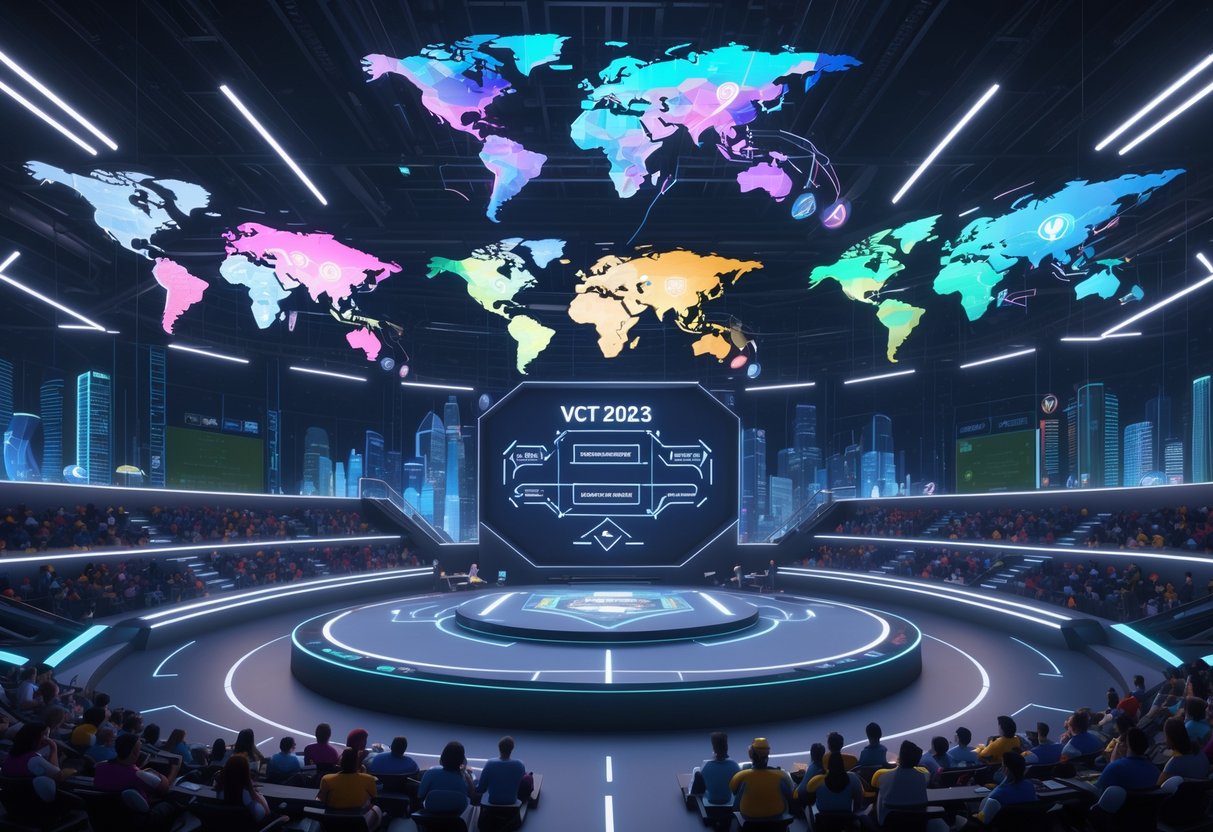VCT 2025 Format Changes: Key Updates and Impacts on the VALORANT Champions Tour
Updated On: October 23, 2025 by Aaron Connolly
VCT 2025 Format Overview
The VALORANT Champions Tour 2025 shakes things up with twelve-team leagues in four regions and a much longer season, stretching from January to October. Teams get at least 12 matches, and the new stage resets mean fresh matchups along the way.
There’s also an updated Championship Points system that decides qualification paths. No more sitting around waiting for a single event to decide your fate.
Major Format Updates
VCT 2025 bumps up the total from 32 to 48 teams across its four leagues. Each region now fields 12 teams instead of 10.
The season actually runs from January to October, with more breathing room between events. Teams finally get time to prepare—and maybe, just maybe, avoid burning out.
Key changes you’ll notice:
- Stage resets: Each stage splits into two groups of six, then reshuffles mid-season for new matchups.
- Expanded playoffs: Regional leagues now have eight-team double-elimination brackets.
- More matches: Teams play anywhere from 12 up to 23 matches before global events. That’s a lot of Valorant.
Teams can make it to Champions Paris through more than one route. Two teams qualify via Stage 2 Playoffs, and another two get in through Championship Points.
The Championship Points system now gives out points at every stage and global event. Masters Toronto offers the biggest haul, with winners picking up 7 points compared to 5 for regional playoff champs.
Comparison to Previous Seasons
Earlier VCT seasons only had 10 teams per region and a much shorter calendar. Teams played fewer matches, and the qualification options felt pretty limited.
Here’s what’s different:
- Team count: 32 teams (2024) → 48 teams (2025)
- Season length: Short calendar → January to October
- Qualification: Fewer options → Points and playoffs both matter now
The old system leaned hard on single-elimination brackets. Now, VCT 2025 goes with double-elimination, so teams get second chances.
Championship spots used to hinge on recent performance. The new points system rewards teams that stay consistent all year, but it still leaves room for those late-season miracle runs.
Official Riot Announcements
Riot Games rolled out the VCT 2025 changes on August 20, 2024, with a YouTube announcement. Later, on November 26, 2024, they shared more details about Championship Points and the new tournament formats.
Global events schedule:
- Masters Bangkok: February 20 – March 2 (eight-team Swiss Stage)
- Masters Toronto: June 7 – June 22 (twelve teams, similar to Shanghai)
- Champions Paris: September 12 – October 5 (sixteen teams, four groups of four)
Kickoff tournaments start the year with double-elimination brackets. China kicks off on January 11, then EMEA (15th), Americas (16th), and Pacific (18th) follow.
Top four teams from 2024 get byes into the second round of Kickoff. Winners from Kickoff head straight to Masters Bangkok with the regional runners-up.
Group Stage Structure Adjustments

VCT 2025 switches up the group stage structure, and honestly, it’s about time. The new setup changes how teams land in groups and tweaks seeding, which definitely affects who qualifies for what.
We’re seeing new methods for group distribution and seeding protocols that could really shake up the tournament flow.
Group Distribution Changes
The 2025 tour brings in updated group setups for different stages. Champions 2025 uses four double-elimination groups in a GSL format for the group stage.
Here’s what’s new:
- Champions format: Four groups, double-elimination brackets.
- Stage competitions: Two single round-robin groups of six teams each.
- Expanded participation: Stage 2 now features eight teams instead of six.
In Americas Stage 1, each group has six teams playing single round-robin. Every match is best-of-three, so upsets can and do happen.
Advancement is pretty clear:
- Top four from each group move on to playoffs.
- Group winners get byes into Upper Bracket Semifinals.
- Second and third place teams enter Upper Bracket Round 1.
- Fourth place teams drop into Lower Bracket Round 1.
This setup opens more doors for teams to qualify for global events, while keeping things balanced across regions.
Seeding and Draw Rules
The new seeding system gives priority to championship points and regional performance. Teams can qualify either through playoff results or by racking up championship points over the season.
Seeding goes like this:
- Regional playoff winners get top seeds and auto-qualification.
- Championship points leaders qualify based on their season-long performance.
- Regional reps ensure all regions get fair representation.
Sixteen teams make it to Champions, but the split between playoff and points-based qualifiers is still getting fine-tuned.
Masters events still matter for seeding. How teams perform at Masters Bangkok and Toronto directly impacts their points and later tournament seeds.
Regional balance is a big deal here. The system rewards teams that stay strong all season and doesn’t punish one bad tournament as much as before.
Playoffs and Knockout Stage Innovations
VCT 2025 playoffs get a big overhaul. Riot expands playoff brackets to eight teams per region and brings in new double-elimination formats across stages.
Bracketing Modifications
Stage 1 and Stage 2 playoffs now include eight teams instead of six in each regional league. More teams get a real shot at events like Masters Toronto.
Kickoff tournaments switch to a straight double-elimination bracket with 12 teams. Before, Kickoff had 11 teams and a different format. Now, the top two from each region’s Kickoff go directly to Masters Bangkok.
Regional playoff changes:
- Americas, EMEA, and Pacific all run 8-team playoff formats.
- Groups get shuffled between Stage 1 and Stage 2 for better balance.
- Longer breaks between playoff events help players avoid burnout.
Stage 2 playoffs now serve as the main path to Champions Paris. The top two teams from each region’s Stage 2 playoffs lock in their world championship spots.
Teams now know exactly what they need to do in playoffs to make it to international events.
Best-of-Series Alterations
Champions Paris keeps the two-stage format: group stage and playoffs. The group stage has four groups of four, each using double-elimination brackets.
Eight teams make it out of groups and into the Champions playoffs. This setup mirrors what worked in previous VCT seasons but fits the larger 16-team field.
Series format details:
- Group stage: September 12–22, 2025
- Four double-elimination groups set playoff seeding
- Playoff bracket uses traditional knockout progression
The championship points system now gives more to teams who do well at Masters events. Teams can qualify for Champions by either reaching Stage 2 grand finals or collecting enough points throughout the season.
That means teams who stay consistent get rewarded, but squads that peak at the right time still have a shot.
Qualification Pathways in 2025

Teams can reach Champions Paris in a few different ways now. The new system rewards teams who perform all season, not just in a single event.
Direct qualification through regional playoffs mixes with points earned from every tournament and match win all year long.
Circuit Points System Updates
The 2025 points system spreads rewards out more than before. Teams collect points at every stage, starting with regional matches. Every win adds a point to your total.
Points breakdown:
- Kickoff tournaments: Winner (3 pts), Runner-up (2 pts), 3rd–4th (1 pt each)
- Masters Bangkok: Winner (5 pts), Runner-up (3 pts), 3rd (2 pts), 4th (1 pt)
- Stage 1 Playoffs: Winner (5 pts), Runner-up (3 pts), 3rd (2 pts), 4th (1 pt)
- Masters Toronto: Winner (7 pts), Runner-up (5 pts), 3rd (4 pts), 4th (3 pts), 5th–6th (2 pts each)
- Stage 2 Playoffs: Winner (7 pts), Runner-up (5 pts), 3rd (4 pts), 4th (3 pts)
Two teams per region make it to Champions based on their total points. So, even if a team doesn’t win the last regional tournament, they can still qualify if they’ve been solid all year.
Last Chance Qualifier Revisions
They’ve scrapped the old Last Chance Qualifier. Instead, the expanded points system gives teams more opportunities throughout the season.
Finish top two in Stage 2 playoffs, and you’re in Champions. It’s a much clearer path than before, when only winners from certain tournaments advanced.
The eight-team double-elimination regional playoffs give teams more room to recover from a bad match. Previously, getting knocked out early meant your season was basically over.
Regions like North America and Southeast Asia now have multiple ways to qualify. A single bad tournament doesn’t crush your championship hopes anymore.
Direct Regional Invites
Each region’s top two teams from Stage 2 playoffs get automatic spots at Champions. That’s the simplest route—no need to worry about points or extra qualifiers.
Regional leagues now run with 12 teams each, up from the smaller leagues in past seasons. More teams get a shot at those direct qualification spots.
Top teams from 2024 get byes in Kickoff, so established rosters start with a bit of an edge. Still, every team has to prove themselves over the longer regular season.
Regional champions from Stage 1 playoffs lock in spots at Masters Toronto and get automatic playoff positioning. There are now several tournaments where teams can secure their Champions spot early if they’re on fire.
Regional League Realignment

The 2025 VCT season totally revamps regional leagues. Each league expands to 12 teams, and the season now runs from January to October.
North America League Format
North America’s VCT league grows a lot for 2025. The region moves to a single league with 12 teams.
This gives North American orgs more chances to compete. Teams battle all year for Championship Points, and every squad faces more matches during the regular season.
Main changes:
- League play stretches from January to October.
- Major tournaments use double-elimination brackets.
- The Championship Points system gets a full overhaul.
The bigger format helps develop deeper talent pools. North American teams used to struggle with limited domestic competition, but now they get way more variety in opponents.
Only the top four North American teams make it to VALORANT Champions, so the competition stays fierce. Teams need to stay consistent all season if they want to make it to the top.
SEA and Pacific Region Changes
Big changes are coming to the Pacific region for 2025. Southeast Asia (SEA) teams will now work more closely with the broader Pacific league system.
Pacific region modifications:
- 12-team league structure
- More SEA country representation
- Better travel scheduling between sub-regions
SEA organisations get more exposure to international competition. Teams from Thailand, Malaysia, and the Philippines now regularly clash with Pacific heavyweights.
The new structure helps break down regional isolation. Before, some SEA teams barely got a shot to face top Pacific squads. Now, the expanded format unlocks more routes for emerging talent.
Travel logistics get a lot more attention too. The Pacific region covers huge distances. Riot Games has rolled out scheduling tweaks to cut down on jet lag and travel fatigue.
The Championship Points system has changed to match the bigger competition pool. SEA teams can rack up points in a wider range of matches all season.
Team Eligibility and Roster Rules
VCT 2025 rolls out stricter roster rules and tweaks to international player policies. Riot wants fair competition, but they’re also giving teams more flexibility during transfer windows.
New Roster Lock Policies
The VALORANT Champions Tour now has clearer roster lock windows for the 2025 season. Teams have to lock in their lineups before each stage, unless there’s an emergency.
Transfer windows open up between the big tournaments. Organisations can swap out players or bring in new faces during these breaks.
Emergency substitutions are still allowed if a player gets sick or runs into visa trouble. Teams need to show proper paperwork to officials, and the substitute must meet all eligibility rules.
Riot’s competitive ops team has to approve every roster change. Teams can’t just swap players at the last minute and expect it to go unnoticed.
Every roster move needs to be wrapped up at least 48 hours before the next official match. This gives everyone a fair shot at preparing.
International Player Guidelines
Each VCT team can use up to two import players from outside their home region. This rule covers Americas, EMEA, and Pacific leagues.
Players earn residency after competing in a region for two full years. Once they hit that mark, they don’t count as imports anymore. That should help foster regional growth in the long run.
Visa requirements can get tricky and depend on the event and the player’s nationality. Teams need to get all documents sorted well ahead of time. Riot offers support, but the final responsibility sits with the organisations.
New rules stop teams from poaching players mid-season with massive contracts. Every transfer has to follow contract terms and buyout rules. Players can’t just jump ship without proper legal steps.
The rules cover coaching staff eligibility too, but with fewer import restrictions. Teams can hire international coaches without worrying about the two-player import cap.
Prize Pool and Reward System Updates

VCT 2025 brings a fresh Championship Points system and bigger prize pools—$2.25 million for Champions Paris, to be exact. The setup now rewards teams for staying consistent across tournaments, but the top prizes are still huge.
Distribution Structure
The VALORANT Champions Tour is boosting its prize distribution for 2025. Champions Paris gets a $2,250,000 prize pool, which is massive for VALORANT.
The new Championship Points system lets teams earn rewards at more events. Unlike 2024, there are now five tournament types where teams can score points.
Key changes include:
- Masters 1 Bangkok: Winners get 5 points (up from 3)
- Masters 2 Toronto: First place now gets 7 points
- Stage tournaments: Stage winners earn 5 points
- Kickoff events: Regional champs can grab 3 points max
Teams that finish 2nd through 6th now get graduated point rewards. That opens up more ways to qualify for Champions, not just through winning.
Performance Incentives
VCT 2025 puts a premium on steady performance, not just single tournament wins. Regular season victories now give 1 Championship Point, so every match matters.
Playoffs have doubled in size—8 teams per region can now fight for serious prize money. That’s a big jump from the old 6-team playoffs.
New incentive tiers:
- Champions qualification: Top 2 Stage 2 finishers plus teams with the most points
- Regional success: Bigger prize pools for league playoff teams
- Consistency rewards: Points for regular season and group stage wins
Ascension teams now have new requirements. If they finish 5th-8th, they can defend their VCT spot. Qualifying for Champions locks in their league spot for 2026.
This system rewards both peak performances and season-long grind, giving teams more ways to earn.
Scheduling and Broadcast Changes
VCT 2025 stretches the competitive calendar from January to October instead of wrapping in August. The longer schedule means more spaced-out tournaments and more chances for fans to watch.
Calendar Adjustments
The Valorant Champions Tour 2025 kicks off on 11th January with VCT CN Kickoff and runs until 5th October, ending with Champions. That’s quite a bit longer than before.
Key timing improvements:
- At least 15 days off between major tournaments
- Earlier season start for better pacing
- Shorter off-season to reduce viewer burnout
Teams and players actually asked for this after 2024’s packed schedule left everyone exhausted. The longer calendar gives teams more prep time.
Every international league now has 12 teams and uses double-elimination from the start. That means more matches but keeps things fair.
Quick win: Use the extra downtime to catch up on highlights if you miss anything live.
Playoffs now have eight teams instead of six, so there are more knockout rounds. More teams in the mix means extra broadcast days and more to watch.
Match Viewing Experience Enhancements
The extended schedule means fans get more regular matches, no matter where they live. The longer breaks between events help international viewers plan ahead.
Stage resets make every stage a fresh shot at playoffs. Points carry over, but win-loss records reset. That should keep things spicy all year.
Now, two teams qualify for Champions based on points, not just one. It’s a small change, but it matters for those grinding all season.
Warning: Double-check regional broadcast times—the longer calendar might shuffle local schedules.
Extra matches from bigger playoffs mean more weekend content. Double-elimination keeps fan-favourite teams alive longer.
Broadcast partners get more content to fill prime slots. The regular 15-day breaks help them plan special segments and analysis between events.
Impact on Teams and Players

The 2025 VCT changes force teams to rethink how they prepare and build rosters. The season now runs from January to October, and the new formats demand fresh strategies and new approaches to player development.
Strategic Adaptations
Teams have to adjust to a straight double-elimination bracket in Kickoff events, now with 12 teams. Every match just got a bit more serious.
The longer season means teams need to rethink their prep cycles. With Masters Bangkok in February-March and Masters Toronto in June, there’s hardly any downtime between the big events.
Stage 2’s jump from six to eight teams opens up more qualifying spots. Teams that used to miss out now have extra shots at events like Champions Paris.
The new points system puts a premium on consistent results. Teams can’t just bank on one good run to make Champions anymore.
Mid-season group reshuffles add a layer of tactical chaos. Teams need to prep for a wider variety of opponents and playstyles, so broad strategic know-how is a must.
Roster Development Trends
VCT 2025’s longer season means roster planning matters more than ever. Teams need players who can stay sharp for a whole 10 months—not just a few weeks.
More international events mean more travel and less time at home. Teams have to keep their rosters stable to handle jet lag and scheduling headaches.
Ascension teams now get to stick around in partner leagues longer if they earn it. That helps cut down on roster churn and gives up-and-coming talent more time to develop.
Teams are putting more resources into coaching staff and analysts to handle all the extra complexity. The new points system means performance tracking is more important than ever.
Burnout is a real risk with the longer season. Teams have to balance hard practice with player wellbeing to stay competitive.
Effects on Regional Representation

The 2025 VCT format shakes up how regions compete on the world stage. North America gets more chances for teams to shine, while Southeast Asia faces new hurdles in making it internationally.
Growth in North America
North America gets a boost from the new VCT setup. The longer season and expanded league formats mean more time for teams to prove themselves.
Team Development Improvements:
- Longer season supports player development
- More matches equal more practice against tough opponents
- Less pressure from sudden-death formats
The points-based qualification system is a real help for NA teams. If a team does well all season, they can still make Champions even without winning Stage 2.
Quick win: Watch NA teams all season, not just in playoffs, to see how the new system plays out.
This should help with the old problem of strong NA teams missing out on international events because of bad timing. Teams like Cloud9 or 100 Thieves can now build momentum over months, not just one event.
SEA and Asia-Pacific Implications
Southeast Asia faces some tough adjustments under the 2025 rules. The Pacific region setup means SEA teams have to beat out established Australian and Japanese squads for a limited number of spots.
Regional Competition Challenges:
- Four teams per region makes competition fierce
- No wildcard slots means no backup plan
- Pacific teams often have bigger budgets
Losing the Last Chance Qualifiers hits SEA teams hard. Those tournaments used to offer a second shot for teams that started slow but finished strong.
Warning: SEA teams need to stay consistent all season—not just show up for playoffs.
A lot of SEA organisations don’t have the same financial muscle as Pacific rivals. That puts the pressure on to perform fast, rather than building slowly.
The points system might give the edge to teams with better coaching and stable rosters—areas where some SEA squads still lag behind the more established Pacific organisations.
Community and Fan Reactions

Fans and pros have been buzzing about the VCT 2025 changes. Some love the longer season and expanded format, while others aren’t convinced it’s all for the better.
Social Media Buzz
Valorant fans have taken over Twitter and Reddit with their opinions on the 2025 changes. Most of the chatter centers on the longer January-to-October schedule.
A lot of supporters really like the longer breaks between tournaments. They think this will help prevent burnout and maybe even lead to better matches.
Popular fan requests include:
- Team-themed weapon skins for tournaments
- Better playoff formats with more exciting matches
- Improved championship points distribution
The VCT Season Capsule announcement got mixed reactions. Some folks weren’t thrilled with the Karambit design, but others seemed to enjoy the new cosmetic options.
Reddit threads bring up concerns about the stage reset system. Players wonder how win-loss records might mess with team momentum between stages.
Twitter polls show 65% of fans support the expanded 8-team playoffs format. They’re hoping for more competitive games and maybe some wild underdog stories.
Feedback from Players
Professional Valorant players have shared some cautious optimism about the new format. Most of them welcome the 15-day breaks between major tournaments.
Several pros called out VCT 2024’s packed schedule. The new setup gives them more rest and training time, which sounds like a relief.
Key player concerns include:
- Adapting to the new championship points system
- Managing longer season commitments
- Balancing practice with expanded tournament schedules
Semi-pro players seem happy about the increased opportunities. The 48-team structure and three international leagues open up more chances to compete.
Coaches like the stage reset idea. They say separate stage records will make competition fairer and take some pressure off early in the season.
A lot of players want better team collaboration features in future updates. They’re looking for new tools to help with strategy during the longer season.
Frequently Asked Questions

The new VCT 2025 format brings some big changes to team qualification paths and how championship points work. Teams now get more ways to reach Champions Paris, and the expanded 48-team setup creates fresh opportunities in every region.
How do teams qualify for the Valorant Champions Tour under the new 2025 format?
Teams can make it to Champions Paris through two main routes. The first is finishing in the top 2 at Stage 2 Playoffs in their regional league.
The second path rewards teams for consistency. Teams rack up championship points, and the top 2 not already qualified through playoffs get their spot.
Teams earn championship points from a bunch of places. Regular season matches give 1 point per win, while playoffs and Kickoff tournaments hand out points to the top 4.
Masters events offer more chances to score points. Masters Bangkok gives points to the top 4, and Masters Toronto extends that to the top 6.
What are the major differences between the previous format and the VCT 2025 format?
The 2025 season grows to 48 teams across four regions. That’s a pretty big jump in participating organizations.
Three international events now set the pace for the year. Masters Bangkok, Masters Toronto, and Champions Paris each offer more global competition than before.
The championship points system looks totally different now. Points get spread out more, so more teams have a shot all season.
Teams now have two ways to qualify for Champions: through playoff results or by stacking up championship points.
Are there any changes to point allocations or rankings with the 2025 VCT format?
The new championship points system changes how teams earn points. Regular season wins are now worth 1 point each, which rewards teams that stay consistent.
Playoff tournaments give points to the top 4 in each region. That includes both Kickoff tournaments and stage playoffs.
Masters events offer different point values depending on the event. Masters Bangkok focuses on the top 4, while Masters Toronto hands out points to the top 6.
With points spread out more, teams stay in the running longer. Early losses don’t knock teams out as quickly, and the system rewards teams that improve over the season.
Can you explain the structure of regional and international events in the VCT 2025?
Regional play starts with Kickoff tournaments from 11 January to 9 February 2025. Each region hosts its own event, and the top 2 teams move on to Masters Bangkok.
Stage 1 runs in spring 2025, but dates vary by region. The top 3 teams from each league’s Stage 1 playoffs make it to Masters Toronto.
Stage 2 happens in summer 2025 for all regions. The top 2 teams from each Stage 2 playoff, plus 2 teams based on championship points, qualify for Champions Paris.
International events bring three big global competitions. Masters Bangkok follows the Kickoff tournaments, Masters Toronto wraps up Stage 1, and Champions Paris finishes out the year in late 2025.
Have the rules for player transfers or team compositions changed with the new VCT format?
There’s no clear info yet about changes to player transfer rules for VCT 2025. The announcements so far haven’t detailed anything about transfer regulations or roster requirements.
Teams keep working within the 48-slot structure across four regions. The bigger league setup suggests roster stability still matters for earning points.
We’ll probably hear about any player movement or composition changes from Riot Games closer to the season start. Those details usually drop separately from the main format updates.
What impact does the VCT 2025 format have on smaller or emerging regions?
The expanded 48-team structure actually gives developing regions a lot more chances to shine. Each of the four major regions—EMEA, Pacific, China, and Americas—now gets a bigger slice of the pie.
For 2025, organizers have added new team promotions. That move brings in fresh talent, letting up-and-coming squads play right next to the big names.
The championship points system, which they’ve updated, really helps emerging teams. Teams can qualify through several different paths, so nobody needs a flawless playoff run just to make it to international play.
Points now get spread out across the regular season and tournament games, not just the finals. This setup rewards consistency, so smaller regions can actually compete by staying solid all season instead of needing some miracle tournament win.


